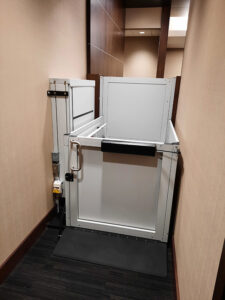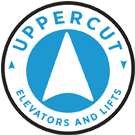Commercial accessibility lifts are a cost effective solution when it comes to making public buildings accessible. Vertical platform lifts or VPL’s can eliminate barriers for wheelchair users or those faced with mobility issues. Their relatively small footprint and minimal contractual requirement make them ideal for existing public buildings where accessibility is a concern. They do however have their limitations under the B-355 code, which they are inspected.
 The first consideration is platform size. Public accessibility lifts are mandated to have a platform that is no greater the 21 square feet. A typical “large” wheelchair lift would have a 48″x 60″platform. This size of platform is big enough to accommodate a wheelchair user doing a 90-degree turn. A more common size would be in the range of 34″ x 54″ where the user enters and exits on the same side, or travels through the platform and exits on the opposite side.
The first consideration is platform size. Public accessibility lifts are mandated to have a platform that is no greater the 21 square feet. A typical “large” wheelchair lift would have a 48″x 60″platform. This size of platform is big enough to accommodate a wheelchair user doing a 90-degree turn. A more common size would be in the range of 34″ x 54″ where the user enters and exits on the same side, or travels through the platform and exits on the opposite side.
Next, we must look at the travel restrictions that are imposed within the code. Enclosed B-355 accessibility lifts can travel no more than 7000mm or 23.1 feet. Unenclosed wheelchair lifts can travel up to 2500mm or 98.25″. Enclosed units will require a hoistway constructed around the device with a door at the lower landings and the minimum of a gate at the uppermost landing. Unenclosed units travelling more than 500mm (19.65″) will require a gate or a door at the upper landing. It should be noted that any lift penetrating a floor will be required to be an enclosed vertical platform lift needing a hoist-way constructed.
The weight capacity of wheelchair accessibility lifts varies from manufacturer to manufacturer, but most unenclosed vertical platform lifts have a capacity of either 550lbs or 750lbs. Enclosed units usually have a capacity somewhere between 750lbs – 1400lbs.
 Perhaps the biggest drawback of public accessibility lifts is the requirement for them to operate using constant pressure. This simply means you must hold the button for the device to operate. This is partially due to the fact the lift platform has no gate or sliding elevator door.
Perhaps the biggest drawback of public accessibility lifts is the requirement for them to operate using constant pressure. This simply means you must hold the button for the device to operate. This is partially due to the fact the lift platform has no gate or sliding elevator door.
As universal accessibility for all members of society is now considered the norm , the popularity of these barrier free lifts has increased. You can find barrier-free accessibility lifts in most schools, community centres and places of worship.
For more information on commercial accessibility lifts please contact us for a free consultation
